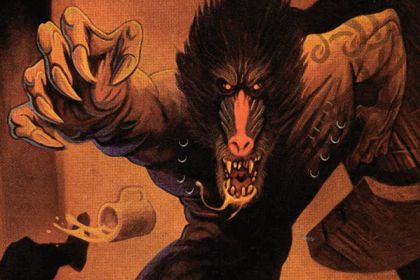

The Lonesome Road

| Climate/Terrain: | Tropical forests, plains and mountains |
|---|---|
| Frequency: | Rare |
| Organization: | Troop |
| Activity Cycle: | Day |
| Diet: | Omnivore |
| Intelligence: | Exceptional (15-16) |
| Treasure: | A,W |
| Alignment: | Lawful evil |
| No. Appearing: | 1-8 |
| Armor Class: | 5 |
| Movement: | 12 |
| Hit Dice: | 5+2 |
| THAC0: | 15 |
| No. of Attacks: | 1 |
| Damage/Attack: | By weapon or 2d6 |
| Special Attacks: | Shriek |
| Special Defenses: | +1 or Bronze to Hit |
| Magic Resistance: | Nil |
| Size: | M |
| Morale: | Elite (13) |
| XP Value: | 970 |
In their human aspect, werebaboons look like typical humans from tropical climes: dark-skinned, with tightly curled hair and large, handsome features. Most, however, have olive-green eyes, an unusual trait among such people. They dress in cool, sensible garments appropriate to their tropical homelands, woven and dyed in vibrant, earthy colors. The werebaboon’s beast aspect is a powerfully built baboon, with a thick coat of fur and impressive jaws. The bizarre hybrid aspect resembles nothing so much as a cross between a baboon and a human. The flesh turns a ruddy pink color and grows an even coat of brown, olive-tinted fur. The creature sprouts a non-prehensile tail, and its feet become capable of limited manipulation. The head transforms into that of a fearsome baboon, the jaws elongating into a viscious doglike muzzle with razor canines. Males typically have a mane of long gray fur.
Werebaboons are usually fluent in local dialects, ancient languages and their own harsh, barking tongue.
Combat: Werebaboons prefer to fight with weapons, even in hybrid aspect, but will use their powerful bite if neccessary. Most wield steel bastard swords or polearms, as well as short bows. Those with a free hand will also use shields. If fighting unarmed, a werebaboon may bite for 2d6 damage. Males always take the resonsibility to fight while females and young flee, though cornered females will fight in defense of their offspring. Werebaboons are excellent climbers when in hybrid form (85%), and will often use this to their adavantage in combat. In fact, they are not above using any craven tactic which would give them an edge.
Once a day, a werebaboon may unleash an ear-piercing screech that affects all those who hear it as if by a shout spell. An entire troop will often scream simultaneously, for the damage effects are cumulative (up to a maximum of six). Werebaboons can only be harmed by magical weapons of at least +1 enchantment or weapons fashioned out of bronze. Their bite carries a 2% chance of infection with lycanthropy per hp of damage inflicted.
Habitat/Society: Werebaboons dwell in tropical climes, preferably within bustling cities. Such places are rare in Ravenloft, however. Most current reports speak of werebaboons living in the Amber Wastes. The lycanthropes lurk within a community, posing as “normal” members of society. Their human personas are usually quite extraordinary, however – wealthy traders, legendary warriors, master thieves, shamans, and even kings. They seek to maintain clandestine control over the city’s resources and destiny through political, social and financial means. A city’s single interrelated population of werebaboons – called a “troop” – meets in secret to discuss its plans and concerns. There is some limited cooperation within the troop: resources are shared, mutual enemies are discussed, and city-wide responsibilities are attended to. However, these meetings are also a forum for fierce power struggles among the males. Rather than attempting to outwit each other through subtle games, conflict is resolved through brutal ritual combat ? to the death.
Werebaboons view themselves as a strong, supernatural race, worthy to assert their dominance over the “carrion”, as they call humanity. They are ruthless and practical, caring nothing for abstract concepts like honor or mercy. They are neither vain nor humble, but will tear to pieces anyone who challenges their authority. Their brutality, however, should not be interpreted as simplicity – they are frighteningly intelligent creatures who are are capable of elaborate deception in their human guises. The main social unit, troop allegiences aside, is the family, which extends into the werebaboons’ human lives. Most households are composed of a male, one or two females, and their offspring – usually a single infant, but sometimes an older juvenille as well. Their lairs are usually urban human homes of extreme comfort.
Werebaboons are surprisingly indifferent to the other lycanthropes with which they come into contact, such as werecrocodiles, werecheetahs, werejackals and werelions. As long as the werebaboons’ masquerade is not jeopardized, a few lone interlopers will be left unmolested. Those who cause trouble are quickly destroyed by the entire troop. Werebaboons do have one mortal enemy: the snake people known as the yuan-ti. The merest rumor that yuan-ti might be in the area is enough to send the troop into a paranoid frenzy.
Ecology: Werebaboons enjoy a rich diet of human flesh, bird eggs, fruits, nuts and tubers. They are social parasites of mythic proportions; tropical cultures fear them and yet remain fascinated by their power.
